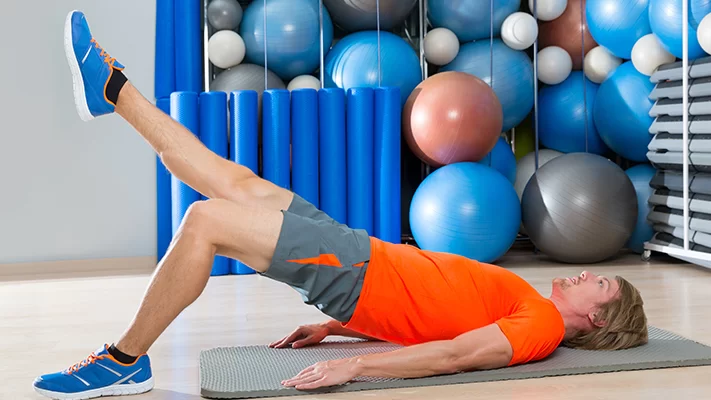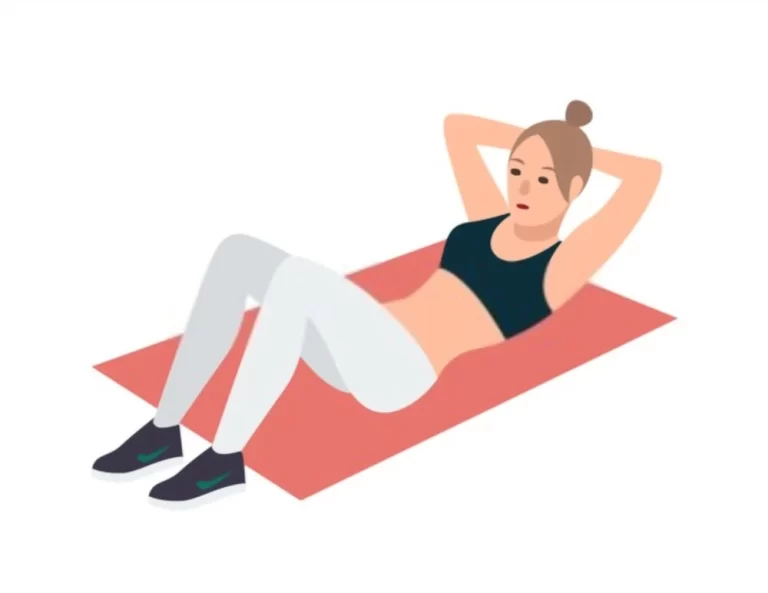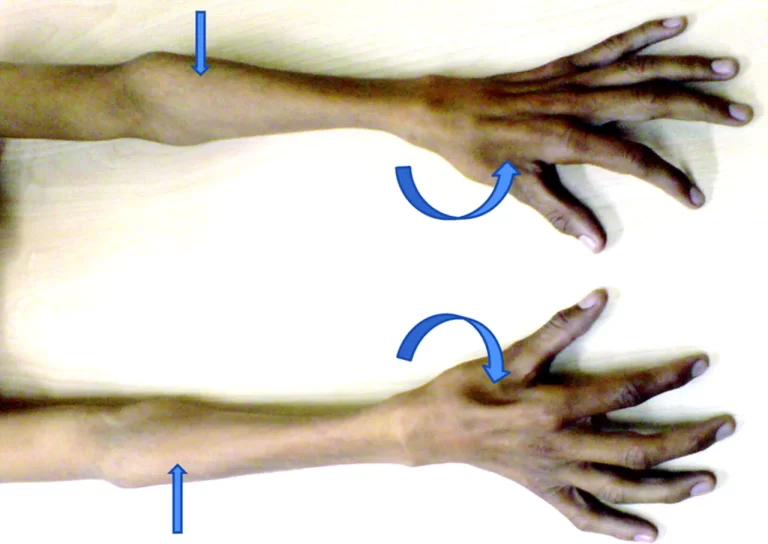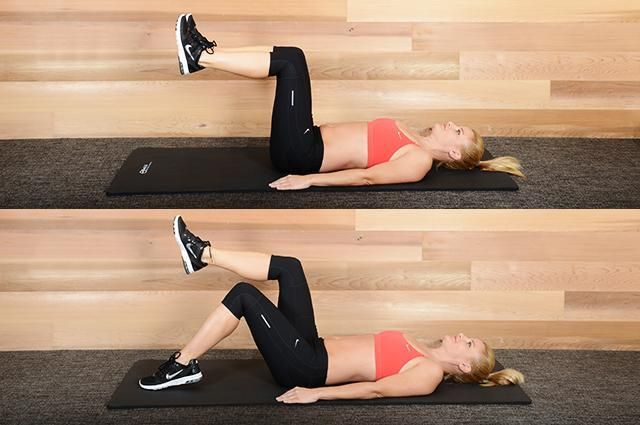42 Best Latissimus Dorsi Exercises
Introduction
The latissimus dorsi, often referred to as the “lats,” is the largest muscle in the upper body and plays a crucial role in various upper-body movements. Developing strong and well-defined lats contributes to a balanced physique and enhances overall upper-body strength. Incorporating effective latissimus dorsi exercises into your workout routine can help achieve these fitness goals.
In this introduction, we will explore some of the best exercises to target the latissimus dorsi. These exercises are designed to engage the lats from different angles, promoting muscle growth, strength, and definition.
Whether you’re a beginner or an experienced fitness enthusiast, including a variety of lat exercises in your training regimen can contribute to a well-rounded and sculpted upper body.
- Typical lat exercises involve a tugging or rowing action because of that movement.
- The lat muscles can be worked in a variety of ways with dumbbells and resistance bands by performing the exercises below.
- Keep in mind that while these are big muscles, depending on the activity, you can usually use a heavier weight.
What Is The Latissimus Dorsi?
Known by most as the lats, the latissimus dorsi is a large, flat, triangular muscle that spans the width of your middle and lower back.
Naturally, you have two lats one on each side of your lumbar region.
The Latin roots of the word “latissimus dorsi” are “broadest” and “dorsum,” which imply “back.”
The muscle is just what the name suggests.
- It is your back’s biggest and broadest muscle.
- It is, in actuality, the biggest muscle in your upper body.
- The lats are what people mean when they say, “build back width.”
- If you’re advanced enough, you’ll have that amazing v-taper appearance.
Anatomy Of The Latissimus Dorsi
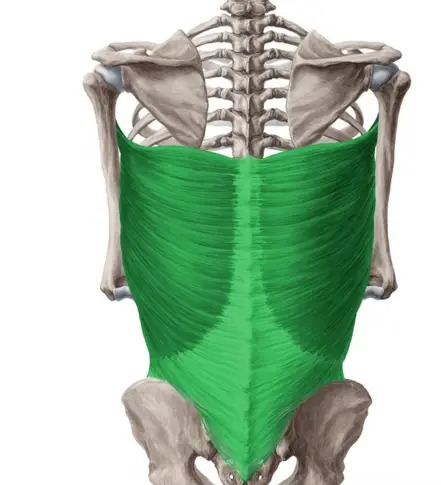
- The latissimus dorsi originates in the bottom half of the scapula, the thoracolumbar fascia, and the spine (from T7 to L5), and inserts into the humerus, or upper arm bone, beneath the bicep.
- Just moving your palm down your posterior, from under your shoulder to your lower back, will allow you to feel your lats.
- Right at the center-middle region of your back, your lower traps cover a very small portion of the lat.
- The muscle is connected to the anterior attachment of the trapezius muscle on the sharp processes of the lower six thoracic vertebral spinous processes.
- Latissimus dorsi attaches to the supraspinous ligament, the lumbar and sacral spinous processes (T6 to S5 levels), and the thoracolumbar fascia.
- The muscle also attaches to the Weak angle of the scapula, the lower three to four ribs where it links with the external indirect muscle and the posterior pelvic bone.
- The muscle fibers are arranged differently, with the lowest fibers on the thorax being much more vertically orientated and the highest fibers almost horizontally focused.
- The muscle fibers spiral around the anterior portion of the teres major muscle as they extend towards the axilla, inserting as a flat tendon on the floor of the humerus’s intertubercular (bicipital) groove.
- Compared to the teres major attachment on the lateral lip of the sulcus, the latissimus dorsi attachment on the intertubercular sulcus extends more superiorly.
Function Of The Latissimus Dorsi
- The latissimus dorsi is primarily responsible for the internal rotation of the shoulder joint as well as adduction, extension, and horizontal abduction.
- Together with the pectoralis major and teres major, it carries out these movements.
- Adduction: Bringing your arm down from the side towards your body (e.g., wide grip pull-ups)
- Stretching your arms out to the sides, or horizontal abduction (i.e. rows)
- Extension: When performing lat pushdowns or swimming, lowering your arm straight down from a standing position
- Internal Rotation: Arm wrestling, or moving your arm towards your body’s center
- It’s an incredibly powerful muscle that helps your arm move when your body is immobile and vice versa.
- Along with other spinal stabilization functions, the lats help to maintain your scapula against your thorax during upper arm motions.
- Note that most latissimus dorsi-powered exercises also simultaneously activate the teres major, posterior deltoids, long head of the triceps brachii, and other stabilizer muscles of the shoulder and scapula.
- Furthermore, as the majority of complex lat exercises require elbow flexion, the forearms, and biceps will also be worked (this is why bodybuilders frequently work the back and biceps on the same day).
- Therefore, it is impossible to totally isolate the lats.
Upper, Middle, Lower Lats:
- Even though the latissimus dorsi is a single muscle that performs all of the aforementioned activities, different movements change which part of the muscle is most advantageous and hence engages more.
- For this reason, when it comes to fitness, the lats are frequently divided into three sections: the upper, middle, and lower lats.
- When performing movements that entail adduction of the shoulder, the upper lats have a biomechanical advantage.
- When the shoulder is abducted horizontally, the middle lats have a biomechanical advantage.
- Movements involving shoulder extension provide a biomechanical benefit to the lower lats.
- Because of this, it’s crucial to incorporate a range of exercises based on each of these motion types to ensure that your lats develop evenly and fully.
- All things considered, your lats are a large, powerful muscle that functions as a primary mover or stabilizer in almost every complex movement of your upper body.
- Every pulling exercise involves the lats to some extent often to a significant extent and even pushing exercises use them.
Description
Most of the lower posterior thorax is made up of the broad, flat latissimus dorsi muscle.
Although it serves the upper limbs primarily, the muscle is sometimes thought of as an auxiliary muscle for the respiratory system.
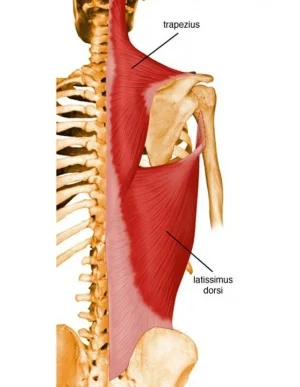
- The latissimus dorsi is a muscle in the superficial layer of the extrinsic back muscles, together with the rhomboid, trapezius, and levator scapulae muscles.
- Functionally, the latissimus dorsi muscle is a part of the shoulder motion muscles.
- This muscle can produce motions on the shoulder joint (internal rotation, adduction, and extension of the arm) by pulling the inferior angle of the scapula in different directions.
Nerve and Blood Supply
- The thoracicodorsal nerve (C6–C8) reaches the muscle on its deep surface from the posterior chord of the brachial plexus.
- The dorsal rami of L1 to L3, as well as the ventral and dorsal rami of roots T4 to T12, supply the skin covering the latissimus dorsi muscle.
Action
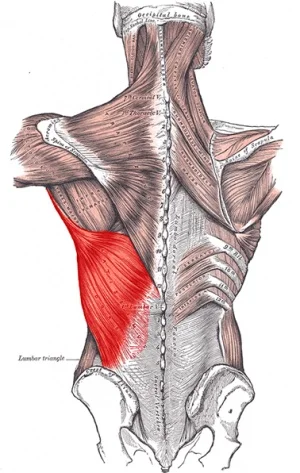
- Together with the teres major and pectoralis major, the latissimus dorsi performs upper extremity movements.
- At the glenohumeral joint, these muscles will cooperate to adduct, rotate medially, and extend the arm.
- The sternal head of the pectoralis major and teres major, in addition to latissimus dorsi, are involved in the extension of the humerus.
- Starting from a partial flexion or abduction position, or a mix of the two, will result in the strongest extension and adduction.
- When the upper extremities are fixed overhead, as in climbing or executing a chin-up, the muscle is also active in propelling the trunk forward and upward.
- Additionally, studies have shown that the latissimus dorsi is engaged in vigorous respiratory processes such as coughing and sneezing as well as deep inspiration.
Functional Activity
- Climbing muscles include the laisses dorsi.
- With the aid of the pectoralis major, it is able to elevate the trunk upward when the arms are fastened above the head. It is a crucial muscle for swimming, rowing, and chopping, particularly on the downstroke.
- Because it joins to the ribs, the muscle is also involved in violent expiration.
- The muscle compresses the thorax and abdomen during coughing or sneezing, causing a forceful inward press.
- When using the upper limbs, the muscle helps support the scapula against the thorax.
- This is made possible by the muscle’s connection to the scapula’s inferior angle.
- Latissimus dorsi can bring the trunk forward in relation to the arms during activities like crutch walking when the humerus becomes the fixed point when standing.
- The pelvis is also raised as a result of this motion.
- Due to the latissimus dorsi’s attachment to the pelvis and its continued innervation, individuals who have lower limb paralysis are nonetheless able to move their trunk and pelvis.
- This means that those who use crutches and calipers can create a modified gait by hitting the hips with alternate contractions of each latissimus dorsi and fixing the arms.
- Owing to its extensive attachment to the spinous processes, this muscle’s potential function in trunk movement is still being investigated.
- The amount of influence this muscle has on rotation, lateral flexion, or spine extension is now the subject of conflicting research.
Physiotherapy
Patients who experience limitations in their ability to abduct, flex, or rotate laterally may have latissimus dorsi.
When evaluating a patient with upper extremity pathology, this muscle must be assessed.
The teres major and pectoralis major muscles must work properly in order for the upper extremities to move smoothly and fluidly.
- The back’s latissimus dorsi are a crucial component.
- There are several great advantages to lat exercise done well.
- These benefits extend beyond bodybuilders, who should be aware of the advantages of strengthening their back muscles, including benefits for daily movement and life in general.
- A beginner’s chair-assisted chin-up is an example of a strength workout.
- Due to its attachments to the spine and pelvis, the latissimus dorsi should be measured for length and flexibility in individuals with low back discomfort.
- This muscle can change in length or stiffness, which can cause changes in posture and/or movement patterns that decrease low back discomfort.
Palpation
- The posterior border of the axilla is constructed by the lateral side of the latissimus dorsi muscle.
- When the arm is resisted, it is perceived to contract.
- It is inserted anteriorly at the smaller tuberosity’s crest.
- Latissimus dorsi can be forced to protrude in relation to the thorax by requesting a patient to elevate his or her arm to 90% flexion and keep it firm against an upwardly directed push.
- By holding the posterior axillary fold between the finger and thumb and requesting the patient to cough, physicians can feel a muscular contraction.
Muscle Testing
- The latissimus dorsi muscle is tested while the subject is prone, with the elbow extended and the arm fully extended. The forearm experiences resistance during abduction and mild flexion.
- The back will stretch and rotate when the upper extremity is flexed into an overhead posture, such as when reaching for something on a high shelf, if the latissimus dorsi is short or tight.
- The accomplishment of the upper extremity’s overhead position is made possible by the spine’s accommodation of extension and rotation.
Creating Your Lat Workout
Create your own lat exercise regimen by following the advice below:
Beginners
- Do 1-2 sets of 1-2 exercises, 12–16 repetitions per set.
- One-arm dumbbell rows and seated rows with a resistance band would be wise choices.
- These workouts will push your body in a new way since they target the muscles slightly differently.
Intermediate or Advanced
- Select two to four distinct workouts.
- Take a dumbbell row, barbell row, and straight arm pull, for instance.
- To work your muscles in a different way, try experimenting with different routines and equipment.
- Aim for 2–3 sets of 8–12 repetitions, with a break in between.
- Combine lower back and upper back movements to create a comprehensive back workout.
- Make sure you are using enough weight or resistance to finish the appropriate number of repetitions.
Safety and Precautions
- Avoid doing any back workouts that could cause your back beyond than what would be expected from using your targeted muscles in a demanding manner.
- Don’t practice these exercises until you’ve had advice from a personal trainer if you’re not sure how to maintain proper form.
Myths
- The idea that there are exercises that specifically target your upper, mid, or lower lats is untrue.
- Two huge muscles on either side of your middle to lower back are called the latissimus dorsi.
- Since they function as a single unit, your lats will be used in every exercise you do.
- Put another way, you can’t work on only your upper, lower, or mid lats you need to work on the entire muscle.
42 Best Exercises For Latissimus Dorsi
Following are the best exercises for latissimus dorsi
One Arm Row on One Leg
Since rowing on one leg increases the challenge of balance, you will generally utilize a lower weight.

Steps To Follow:
- To begin, tip from the hips and move the weight to the right leg.
- Keep your body parallel to the floor while you raise your left leg straight up. From head to heel, your body should form a straight line.
- If necessary, use a wall as support for your balance.
- Pull your elbow up into a row and then gradually lower yourself from this posture.
Lat Pulls With Bands
The lat pull machine at the gym is similar to the lat pull with bands.
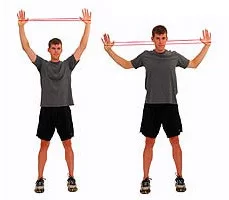
Steps To Follow:
- You can use a door holder to hold your band and fasten it in a doorway above you if you want to increase the difficulty of this workout.
- If not, bring the elbows down towards the rib cage by holding the band overhead and squeezing the back.
- Hold the band with your hands closer together to make it more difficult.
- For a more focused exercise, you can alternatively perform this one arm at a time.
- Do this 12–16 times.
Barbell Rows
Dumbbells let you work each side separately, but a barbell lets you lift more weight than you could with individual weights.

Steps To Follow:
- Starting with your palms facing your body, tip the barbell from your hips until your torso is at a 45-degree angle.
- Lowering your torso too much might put a strain on your back, particularly if you are overweight.
- Squeeze your back to draw the barbell in towards your belly button while maintaining your knees bent to protect your back.
- Do this 12–16 times. This exercise can also be performed with the palms facing out, like a biceps curl.
Dumbbell Pullovers
Pullovers are a fantastic workout since they simultaneously target the lats, chest, and triceps muscles. You work your core and lower body when performing these exercises on a ball.

Steps To Follow:
- Start by holding a weight straight up overhead in the bridge posture.
- Use a lesser weight at first if you’re unfamiliar with this exercise.
- Lift your arms straight and bend your elbows slightly while lowering your weight to your head or as low as it feels comfortable for you.
- Start by slowly pulling the weight back while squeezing your back.
- Repeat for 12–16 repetitions.
Renegade Row
The renegade row improves muscular coordination and dynamic flexibility by using a significant amount of the lower body and core.
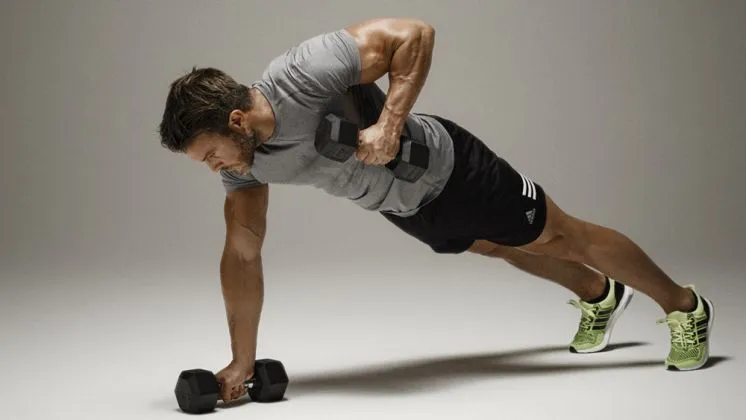
Steps To Follow:
- Start by assuming a plank posture on your hands and knees or toes.
- Grasp two dumbbells with your palms facing opposite directions.
- Try one at a time if your hands are bothered by this.
- For 12–16 repetitions, alternately row each weight up and down while maintaining the plank posture.
- If this is too difficult, perform the same movement on your knees, placing your hands beneath your shoulders and your knees directly under your hips.
Pull Ups
A list of back exercises wouldn’t be complete if pull-ups were left off. Because you’re raising your body weight so high off the ground, they are likely the hardest back workouts. There are techniques to adjust so that you can move and gradually develop the strength to lift your complete body if pull-ups are new to you.
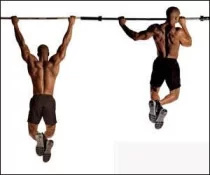
Steps To Follow:
- Place a chair or a sturdy stool below the pull-up bar to begin.
- Spread your hands wider than your shoulders, place one foot or both, if necessary up on the chair, then utilize the leverage to raise yourself up.
- Lower, then do so eight times or more.
- You can experiment with using more of your upper body and less of your lower body over time.
Dumbbell Rows
Hint from the hips for this exercise, maintaining a flat back and contracted abs.
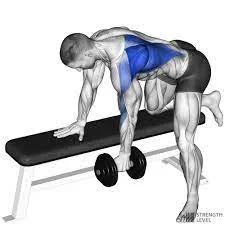
Steps To Follow:
- You lift the elbows up to the level of your torso by squeezing your back while the weights which need to be heavy hang down.
- Instead of yanking the weights up, try to control the movement with your back muscles.
- Just above the level of the torso, the elbows should halt.
- Your lower back has to work hard to maintain your body’s alignment because you’re hunched over and the weights are hanging down.
One Arm Row
Steps To Follow:
- Unlike double-arm rows, where you support your lower back with one hand on the other leg, one-arm rows allow you to often go even heavier.
- Pull the elbow up to the level of your torso to perform this exercise, activating your lat.
- Squeeze the shoulder blades together at the top to engage additional muscles.
- After 12–16 repetitions on each side, decrease the weight.
Seated Rows With Resistance Bands
The entire rowing exercise can be altered with resistance bands.
Your muscle fibers fire somewhat differently because the resistance band provides resistance to the exercise.
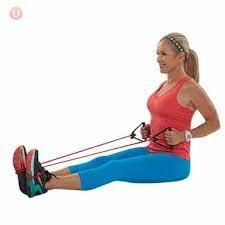
Steps To Follow:
- This is an exercise that you may do standing or seated.
- Take hold of the handles in each hand and wrap a band around something substantial in front of you.
- Retrace your steps until the band is challengingly tense.
- Squeeze the back to row the elbows in while maintaining a downward stance, ending at the level of the torso.
- Repeat 12–16 times after letting go.
Bent Over Row With Bands
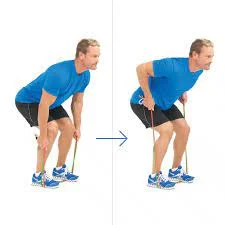
Steps To Follow:
- Grab the band closer to your feet and loop it under both feet for this maneuver.
- By doing this instead of gripping the handles, you can increase the tension in the band.
- Pull the elbows up into a row, halting at the level of the torso, with the back flat and parallel to the floor, or as near as you can manage.
- Do this 12–16 times. Pace changes work really well with this move as well.
- To increase your duration under stress, you could, for instance, begin with 8 rows and then, while maintaining the elbows at the top of the exercise, perform 8 slow, little pulses.
Power Plank With Rows
This challenging workout accomplishes two goals at once. The plank tones the lower back, lower body, and abs.
By adding a row, you can strengthen your lats and core at the same time because you’re balancing your body on one hand.
Steps To Follow:
- With your feet wide apart, begin in the plank position on your hands and toes.
- You can modify this motion by performing it on your knees.
- Grasp a dumbbell or kettlebell and raise your elbows into a row.
- Lower and repeat, holding the plank the entire time, for 12–16 repetitions.
- After a short rest, swap sides.
Dumbbell Rows With Bands
Combining weights and resistance bands is a terrific approach to increase the intensity of your lat practice.
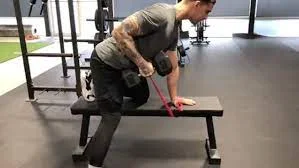
Steps To Follow:
- Start by looping the band beneath your feet and encircling a pair of dumbbells on each side of the band.
- Verify that you can handle each weight securely without falling.
- Row the weights up and down for 12–16 repetitions, tipping from the hips and maintaining a flat back and contracted core.
Alternating Dumbbell Rows
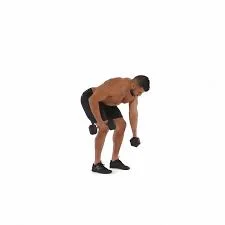
Steps To Follow:
- A variation on the standard dumbbell row is to perform them in a right-to-left sequence.
- This helps you focus on one arm at a time and activates a little more of your core.
- Tip from the hips and maintain a flat back to begin.
- Bring the right elbow up to the level of the torso by bending it slowly.
- Lower the left elbow into a row, then raise it again.
- For 12–16 reps, alternate while taking your time with each rep.
Straight Arm Pulls
Not only does this workout work the back, but it also works the triceps. When you balance on a ball, your legs and lower back stabilize your body.
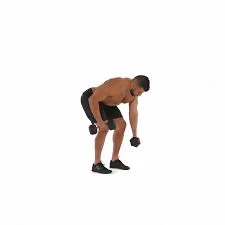
Steps To Follow:
- To accomplish this, place the ball beneath your torso and secure a band around a solid item in front of you.
- Ascertain that there is sufficient distance between you and the anchor for the band to be taut.
- Starting with the arms extended straight in front of you, squeeze the back by pulling them down and back behind you while maintaining their straight posture.
- Do this 12–16 times.
Barbell Pullovers
This exercise gains a significant increase in intensity when performed using a barbell.
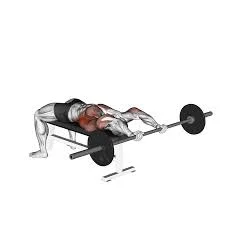
Steps To Follow:
- In contrast to dumbbell pullovers, you should maintain a bent elbow throughout to prevent dropping the weight.
- Beginning on a bench, place your hands close together, just over your ribcage, and hold the barbell.
- Raise the weight and place the arms back behind the head while maintaining a bent elbow position.
- Repeat for 12–16 repetitions, using your back to draw the barbell back to the starting position.
Compound Row

Steps To Follow:
- This dynamic exercise targets the hamstrings, glutes, and lower back in addition to the lats.
- Step back until you can feel the tension in the band after putting it around a firm item in front of you.
- With the arms straight, tip from the hips, knees slightly bent, and abs in.
- As you stand up, lift your elbows to your torso level in a rowing action.
- Repeat 12–16 times after letting go.
Wide Grip Pull-Up
The toughest pull-up version is the wide-grip overhand pull-up. Additionally, it works wonders for the lats. In essence, your lats receive less assistance from other muscles, such as your biceps and forearms, the wider your grip. It’s as solitary as it gets when it comes to lat exercises. The movement’s principal motion is shoulder adduction, which means that the top part of the lats will be most stimulated.
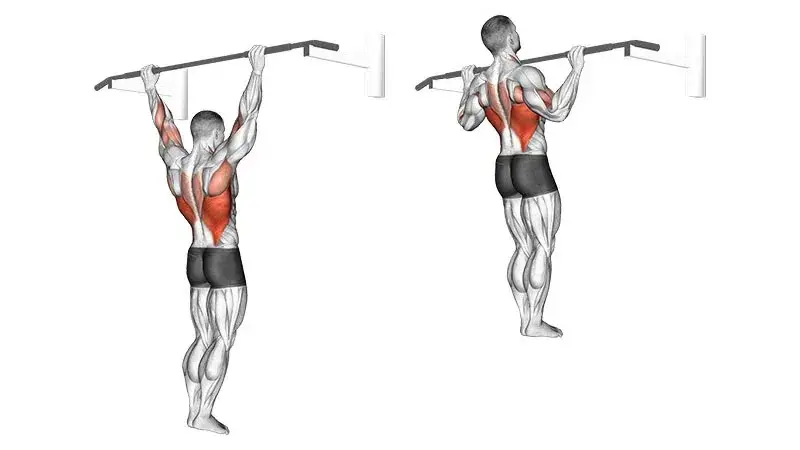
Steps To Follow:
- Avoid spreading your arms too far; starting from the hanging posture, they should form a Y.
- You will still receive excellent lat activation if you move your hands in closer if this is too difficult.
- Make sure your core remains active.
- Glutes as well!
- Draw your scapula down and together from a dead hang to elevate your body a little.
- Afterward, bring your elbows down towards your torso to raise yourself up.
- When your chest is as close to the bar as it can get and your chin is above it, stop.
- At the summit, avoid letting your shoulders curve forward and losing form.
- You should always have your head facing forward.
- For optimal results for lat development, use your entire range of motion on each rep (go all the way down and all the way up!).
Weighted Pull Ups
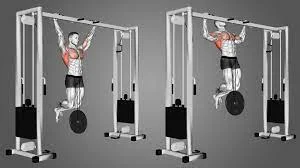
Steps To Follow:
- It’s time to add weight when you can perform wide grip pull-ups for 10–12 repetitions in 3–4 sets.
- After using a dip belt and connecting a plate (lighting up), complete as many pull-ups as you can (six or more).
- After completing 10–12 repetitions, raise the weight a little and try again.
- Should you wish to maintain your development, you must perform weighted pull-ups.
- It’s considerably superior to performing innumerable bodyweight repetitions.
Close Grip Chin Up
The close grip chin-up is more of an all-around back workout than the wide grip pull-up since it uses a lot of other back muscles in addition to your arms to provide force.
Nevertheless, because the close grip chin-up is unique, we adore it.
Close grip chin-ups need more shoulder extension, which means your lower and mid lats will be worked harder during the exercise.
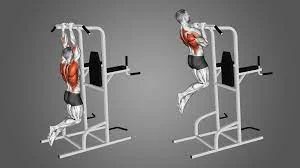
Steps To Follow:
- Hold out your hands with an underhand grip, about three to five inches apart.
- Keep your arms outstretched and hang.
- Pull yourself up until your chest meets the bar, making sure your shoulders are always tucked in and away from your ears.
- If you are able, hold the highest posture for a brief period of time before lowering yourself to a full hang.
- As you lift yourself up, really feel your last contract.
Weighted Chin Ups
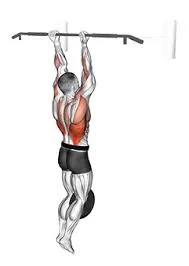
Steps To Follow:
- Similar to pull-ups, you can start adding weight until you can perform 10–12 clean, full reps.
- Before adding extra weight, try to utilize a weight that allows you to complete 5–6 repetitions.
- Then, work your way up to 10–12 repetitions. When weight is added, the same form guidelines apply no cheat reps!
Assisted Pull Ups & Chin Ups
There are two techniques to perform pull-ups for novices who are unable to perform enough for a sufficient volume. You can use bands or a pull-up help machine.
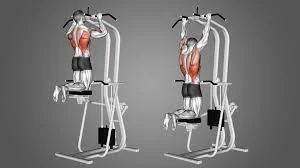
Steps To Follow:
- Alternatively, you can go to a full-fledged pull-up by using the dead hang to strengthen your upper body.
- Try the weight help you require for 6–12 repetitions until you reach failure using a pull-up assist machine.
- Then, gradually reduce the level of support as you advance.
- You will eventually be able to perform chin-ups and bodyweight pull-ups.
- Once you can perform at least five clean repetitions on your own, we advise moving on to pull-ups and chin-ups.
- The function of pull-up assist bands is the same.
- As you advance, you can switch to a lighter band or remove the heavier one that you were using.
- You can also start with many lighter bands.
- You will receive as much support as the band’s complete resistance.
- That means that a band that supports about 80 pounds will effectively remove 80 pounds from your body weight.
- When utilizing two bands at once, add up their combined resistance (for example, 35 pounds of aid from a bright yellow band and 50 pounds of resistance from a black band; that equals 85 pounds of overall assistance).
Wide Grip Cable Lat Pulldown
The cable machines’ equivalent of the wide grip pull-up is the wide grip lat pulldown.
It works your arms similarly (shoulder adduction), thus your lats are worked, with the greatest demand going to your upper lats. You may be asking yourself, “Why do pulldowns if I can already do pull-ups?”
In addition to pull-ups, there are a few other reasons why the cable pulldown is fantastic.
Initially, the pulldown lets you turn up the volume (keep in mind that a high volume is necessary for your lats to develop to their fullest). Sometimes your lats aren’t quite used up in this plane of motion, even though you’re at your limit when it comes to pull-ups. Secondly, the lat pulldown facilitates the process of fine-tuning your lats (mind-muscle connection) so that you can compress and stretch them to the maximum extent feasible. Finally, because you can regulate the weight, pulldowns are a fantastic choice for novices who struggle with pull-ups.
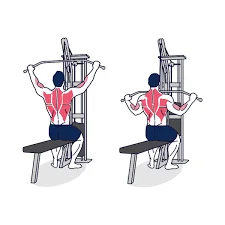
Steps To Follow:
- Remember to keep your torso as erect as possible, much like in a pull-up.
- From the beginning position, your arms should form a Y.
- If necessary, move the seat down so that your arms are extended from the beginning position.
- At the bottom, you should be able to feel your lats stretching.
- Pull down on the bar while pulling your shoulder blades down and together to begin the exercise.
- Next, push your elbows down to your sides.
- Throughout the workout, maintain a straight head and a strong core.
- During the eccentric period, move gently (the upward motion).
Close Grip V-Handle Lat Pulldown
The tight grip lat pull down with v-handle requires a high degree of shoulder extension since it places your hands in a neutral grip and lets you maintain your elbows tucked.
That will give your lower lats an even bigger advantage. Additionally, when you pull down in this form, you should be bending back.
This makes it possible for you to employ more weight and increases the activation of your middle delts, resulting in a more comprehensive lat exercise. Together with your torso’s leaning motion, the close grip lat pulldown will enable you to employ a larger load because it engages more muscles.
Additionally, this exercise will provide you with a significantly wider range of motion than the standard lat pulldown. Thus, rather than just developing bigger lats, this exercise is excellent for developing STRONGER, more mobile lats.

Steps To Follow:
- Make use of a V-bar handle.
- Start with your torso upright and your arms fully extended.
- Keep your head up and brace your core.
- Pulldown first and primarily with your lats.
- Pay attention to your lats only.
- Reverse the pulldown by a small amount.
- Starting erect, your body should form an angle of between 30 and 45 degrees.
- To get the most out of this workout and to put as much strain as possible on your lats, move very slowly during the eccentric period.
Close Underhand Grip Pulldown
Using a close underhand grip with the straight pulldown bar will likewise produce a similar result.
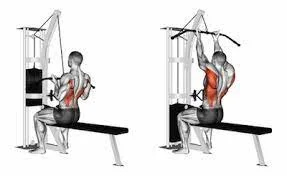
Plate Loaded Pulldown
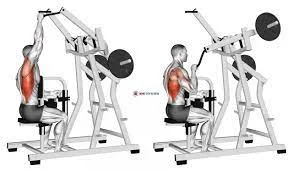
Steps To Follow:
- You can also alternate between using your plate-loaded high-row machine and the cable pulldown on different days.
- Some, such as the one in the picture, can accommodate various angles, allowing you to target different lat muscle groups.
- This one is like a cross between a row and a pulldown.
Cable Crossover Lat Pulldown
The cable crossover machine lat pulldown is a great alternative to work on your lats if you don’t have access to a lat pulldown machine or just want to switch things up. Your grip position is where this variation differs the most. Your hands will be in a neutral position, and your arms will be spread wide. Because of this, it’s excellent for strengthening your teres major and upper lats (shoulder adduction). Not to mention your trapezius lower body.
The lats workout is also great for stretching and squeezing your muscles. With this one, tension can be maximized.
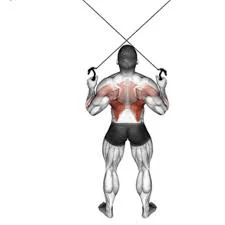
Steps To Follow:
- When in the tall-kneeling posture, adjust the cable crossover machine so that your arms are fully extended and your lats are stretched.
- Make use of stirrup handles.
- With your arms fully extended in a neutral grip, start in a tall kneeling position.
- Brace your core to maintain the position while you bring your elbows down and in towards your body, using your lats to propel the movement.
- To increase the contraction tension, squeeze as hard as you can at the bottom.
- Once your arms are fully extended and your lats are stretched, proceed carefully throughout the eccentric phase.
- You can increase the stretching tension by doing this.
Single Arm Cable Crossover Lat Pulldown
The single-arm lat pulldown with a cable crossover machine is the last lat pulldown on our list.
For this one, you are lining up your body so that the shoulder of your working side is parallel to the pulley. Your lower lats will be worked more as a result of the movement becoming centered on shoulder extension.
You can work on just one side at a time during this exercise, which is beneficial for correcting muscular imbalances and asymmetries. With this one, you can also maximize the range of motion.
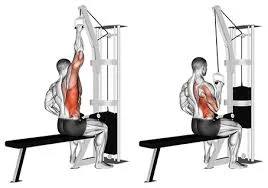
Steps To Follow:
- Put your body in a half-kneeling position so that the shoulder of your working side is parallel to the pulley handle.
- The handle should be raised high enough so that your arm is fully extended and your lats are stretched when you grasp it in the starting position.
- Maintain a neutral grip.
- Draw your elbow straight down while maintaining a straight arm.
- Your elbow should be tucked to your side at the end of the range.
- With your arm completely extended, carefully return your lat to its starting position after squeezing it at the bottom.
Horizontal Pulls
- Weights are pulled in the direction of the body during horizontal pulls.
- To put it another way, rows are horizontal pulls.
- For instance, single-arm dumbbell rows (also known as Kroc rows), t-bar rows, bent-over rows, and sitting cable rows. Rows can be performed with a wide variety of apparatuses and row types.
- You can target different muscles in your back depending on the type of row and how you position your grip.
- Naturally, the rows that most effectively target your latissimus dorsi will be our main focus.
Underhand Bent Over Barbell Row
The queen of rows is the bent-over barbell row.
It’s the row that gives you the highest lifting capacity and is unquestionably the finest way to gain massive muscular mass and develop strong back and pulling muscles.
The underhand and overhand grips are the two main grip varieties used in bent-over barbell rows. Both the overhand and underhand bent over rows target your lats, however, the overhand row focuses more on your upper back (traps and rhomboids), while the underhand row is more focused on your lats (middle and lower).
As a result, the underhand bent-over row, also known as the reverse grip bent-over row, is displayed.

Steps To Follow:
- To slightly exceed parallel with the floor, bend your knee and press your hips back, forming a high hip hinge.
- Then, lean your torso forward.
- There shouldn’t be an arch in the back of your spine.
- Grasp the barbell using an underhand grip, placing your hands slightly outside of your hips, about shoulder-width apart.
- Maintaining your bent-over stance, row back your arms straight until the bar reaches your abs and your arms are fully contracted.
- Return the bar to its lowest position gradually until your elbows are fully extended.
Yates Row
- It is renowned for having an extremely strong back.
- This is a bent-over-row variation with an underhand grip.
- In essence, the same thing happens, except your torso is positioned more upright roughly 30° lower than in the upright posture.
- The bar will still be drawn in the direction of your abs.
- The Yates row has the advantage of hitting your upper back nicely and allowing you to raise heavier weights.
- Gaining more weight is always beneficial for increasing androgenic hormones and general power and muscle growth. Larger deadlifts will result straight from this exercise.
Smith Machine Underhand Bent Over Row
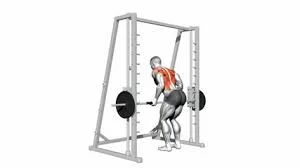
- For those who prefer to concentrate on proper technique and lat isolation during bent-over rows, the Smith machine is a suitable choice.
Dumbbell Underhand Bent Over Row
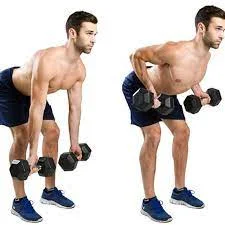
- Dumbbells can also be used for bent-over rows.
- Since each arm will be working separately with dumbbells, both sides will be working equally.
- You may correct muscular imbalances using this.
- Additionally, you can maximize the squeeze at the top of the row by having a wider range of motion during the concentric phase of the dumbbell bent over rows.
EZ Bar Bent Over Row

- Since you may set the EZ bar in a more natural (slightly neutral) posture, the only true advantage for bending over rows is that it is a little easier on your wrists.
Pendlay Row
The lats are one of the key movers in this excellent power and strength workout for the back muscles. The Pendlay row employs a broader grip than the standard overhand bent-over row, which results in more flared arms and a focus on horizontal abduction, or the middle lats, as the primary movement.
Furthermore, you lower the barbell to the floor for each repetition and lift it rapidly and explosively off the floor each time, rowing it up to your lower chest and upper abs rather than your lower or middle abs. All in all, it works every muscle in your back because it is a pure backbuilder. Although it does wonders for your entire lats, the middle lats the largest part of your latissimus dorsi are the focus of this exercise.
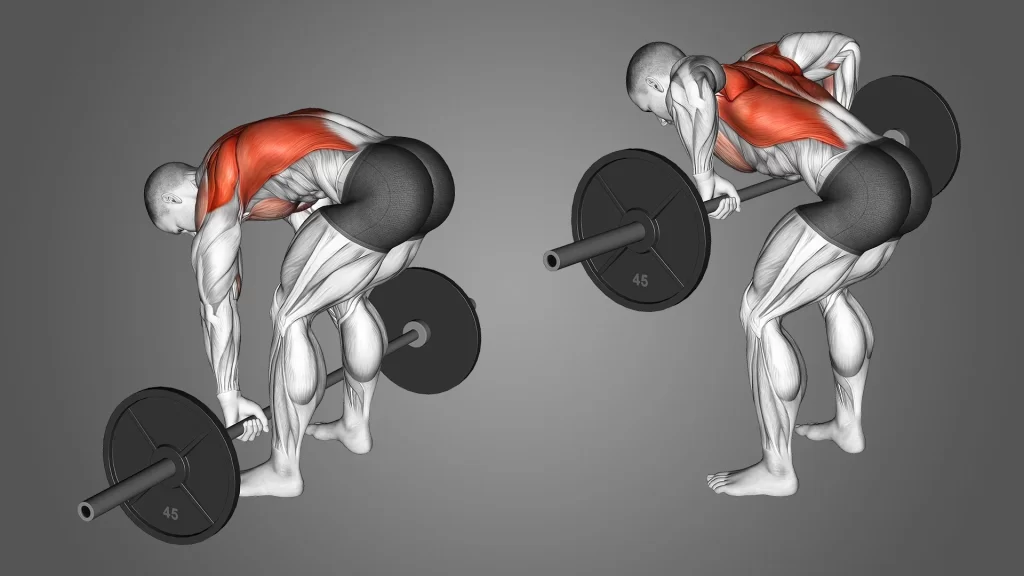
Steps To Follow:
- Bend over and position your body so that it is parallel to the floor.
- Using an overhand grip and hands broader than shoulder width, grab the bar.
- When the barbell is on the floor, explosively row it up to your lower chest and upper abs while maintaining proper technique.
- Return the barbell to the floor as gently as possible, making a dead halt there.
T Bar Row
The v-handle T-bar row is an amazing exercise to develop a wider, thicker back.
It differs from the bent-over barbell row in that it involves different body alignment, grip, and weight placement. You can use a heavier load, you will have a wider range of motion, and the t-bar row hits your lats in a little different way overall.
It works incredibly well to activate your lats’ low center region.

Steps To Follow:
- Take a wide stance over the bar. Put your chest high and your spine straight when you bend over.
- You want to place your feet about 8 to 12 inches behind the plates.
- To get your foot placement down, you can practice first with minimal weight or with the bar empty.
- When you begin, your arms should be fully extended.
- Pull the weight in the direction of your upper abdomen by contracting your glutes and core.
- Once your arms are fully extended, carefully drop the bar back down while maintaining a contraction in your lats.
Kroc Row
The Kroc row, also known as the single arm row, works wonders for your grip strength and entire back, but it also performs a terrific job of engaging your lats over a wide range of motion. It also allows you to apply maximum weight on one side at a time. Using dumbbells is an excellent lat exercise to strengthen your wings.
Not only is it a fantastic workout for your latissimus dorsi, but it’s also a great upper-body exercise in general. It will put a lot of strain on your core through stability, anti-rotation demands, and your forearms and biceps.

Steps To Follow:
- With a dumbbell in your left hand (neutral grip) and your left leg aligned with your hips (including the knee of the supported leg), place your right hand and right knee on the bench.
- Shoulders and hips should be in little elevation. Thus, for the Kroc row, at a 15° inclination from parallel.
- Pull your elbow back and up until your elbows are fully contracted while your left arm is extended.
- With Kroc rows, momentum is a useful tool. (which allows for heavier weight)
- At the top, squeeze as hard as you can, and then gradually drop your arm to its maximum extent.
- To prevent slouching, always maintain your hips and core engaged.
- For the duration of the workout, your torso and hips must be squared forward.
Seated Underhand Rows
Either a row machine (which uses plates, or a cable pulley system) or a cable crossover machine can be used for sitting underhand rows. Regarding targeting the lats, the seated underhand row is similar to the barbell bent-over row; however, it eliminates the need for your lower back and lower body. As a result, it’s more of a lat isolation row exercise or as isolated as possible.
Although you can perform overhand and underhand rows to strengthen your lats, we still advise using both grip variations because the underhand grip will provide superior lat activation.
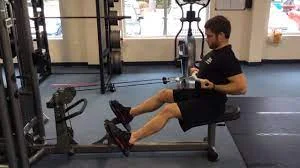
Steps To Follow:
- Assume a posture in which your upper body is completely straight.
- If you need to sit back more, then do so.
- Your arms should be completely extended when grasping the handle (with your underhand grip).
- As much as you can, bring your elbows back; your arms should be fully extended in the final range.
- When you row, avoid bending your torso backward.
- There is only shoulder and arm movement.
- After tensing up your lats to the maximum extent possible, slowly extend your arms again.
- This machine demonstrates how to perform seated chest-supported rows.
For optimal latissimus dorsi muscle activation, we advise raising the seat so that you are rowing to your lower ab level.
Underhand Inverted Rows
Though it’s simpler than a pull-up, the inverted row is really a pull-up of rows. It’s also an excellent bodyweight workout for people who perform bodyweight exercises alone or calisthenics. It’s not limited to bodyweight exercises, either. Bodybuilders also perform inverted rows. Working out on inverted rows can be a terrific technique to fatigue your lats and back completely at the end of a workout. Although it seems simple, it can be really difficult to execute well.
Make use of your entire range of movements. Moreover, elevating your feet off the ground and onto a bench will make the exercise harder. For novices, this is an excellent workout to increase your rowing strength, which will also help you become more proficient in pull-ups and chin-ups. As you have undoubtedly guessed by now, we went with the underhand grip since it specifically targets the lats. One advantage of utilizing a Smith machine is that you can adjust the height of the bar, which lets you adjust how easy or challenging the activity is.
It will be more difficult the closer your body is parallel to the ground.
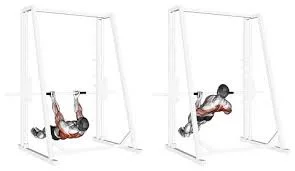
Steps To Follow:
- With your hands shoulder-width apart, take an underhand hold beneath the bar.
- To ensure that your body is fully straight, spread your feet apart.
- If you want to make it harder, put your feet up on a platform.
- Pull your elbows down to raise your torso towards the bar while keeping your arms completely extended.
- Retract your shoulder blades.
- Raise your torso until the bar makes contact with your lower chest and upper abs.
- Return your body to its starting position very slowly, until your arms are fully extended.
Shoulder Extension (pushdowns & Pullovers)
- Although some rows and pulldowns require more shoulder extension than others, they are not solely dependent on it, unlike lat pushdowns and pullovers.
- For the last to fully grow, lat pushdowns and pullovers are therefore necessary.
- Recall that one of the primary functions of the lats is shoulder extension.
- However, on a back day, lat pushdowns and pullovers are more of an auxiliary workout.
- Towards the end of your workout, or just to get the blood flowing to your lats, they should be performed with modest weights.
Lat Pushdown
To date, there has only been one lat workout without any elbow movement, and that is the lat pushdown, commonly known as a pullover. Throughout the entire workout, your arms will stay straight (a tiny bend in the elbow is acceptable). This is only an extension of the shoulder.
It works very well for the bottom middle portion of your lats and is basically an isolation workout for the lats.
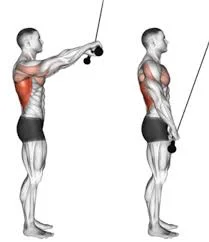
Steps To Follow:
- Assemble a straight bar attachment for a cable pulley machine.
- Spread your hands somewhat wider than the breadth of your shoulders.
- Move a few steps away from the machine so that when you begin with your arms raised, your back and legs feel stretched and tense.
- Press the bar down towards your hips while maintaining a rigid body and fixed arms.
- At the bottom, flex your back firmly, and then slowly raise your arms back to the beginning position.
- Starting with your knees slightly bent, your hips slightly back, and your body slightly forward is another approach to performing the cable pushdown.
- Next, lift your chest proudly and squeeze the hell out of your lats while performing hip extension (bringing your hips to neutral) as you press down.
Seated Incline Lat Pushdown
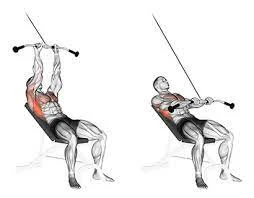
- This is an additional lat pushdown variation.
- You should give this one a try to see whether it works well at helping you concentrate on your lats.
- Essentially, you can be certain that your torso is immobile when using the backrest.
- This one requires you to face away from the machine with an inclined bench.
- As seen in the picture, sit on it, then grasp the straight handle behind you at shoulder width and press down while keeping your arms fixed.
Lat Pullover
The movement pattern of the lat pullover is comparable. Additionally, it is solely an extension of the shoulder. The ability to overload with additional weight during the lift’s stretching phase is the pullover’s main benefit. That being said, when the weight shifts above your head and your chest assumes control, your lats become less active.
Thus, the pullover is a workout for the lat and upper chest, as opposed to the pushdown, which is a lat isolation exercise. The most common piece of equipment is the dumbbell pullover, however, we’ve found that the barbell’s grip and hand placement provide superior lat activation. To find out which one suits you best, you can test both.
This is a two-way exercise.
In the first, your entire back is resting on the bench, and in the second, only your upper back is resting on the bench. See the latter in the dumbbell form below.
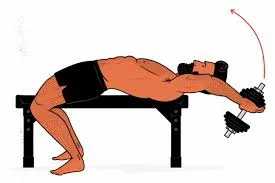
Steps To Follow:
- Start by grabbing an EZ bar or barbell with an overhand grip that is shoulder width apart.
- Then immediately lower the bar again.
- Your elbows should only be slightly bent; otherwise, your arms should be straight.
- Extend your arms as far behind you as is comfortable for you.
- Your goal is to have your lats’ stretching tension feel wonderful.
- After that, pull the bar over till your arms are straight up above your chest while maintaining your arms fixed.
- Pull from the bottom up, using your lats to drive the movement.
- As you carefully lower your arms back behind you, take note of the tension that stretches.
- Once more, maintain a fixed arm position at all times.
- All that’s happening here is shoulder flexion and extension.
- No bending of the elbow.
Dumbbell Pullover
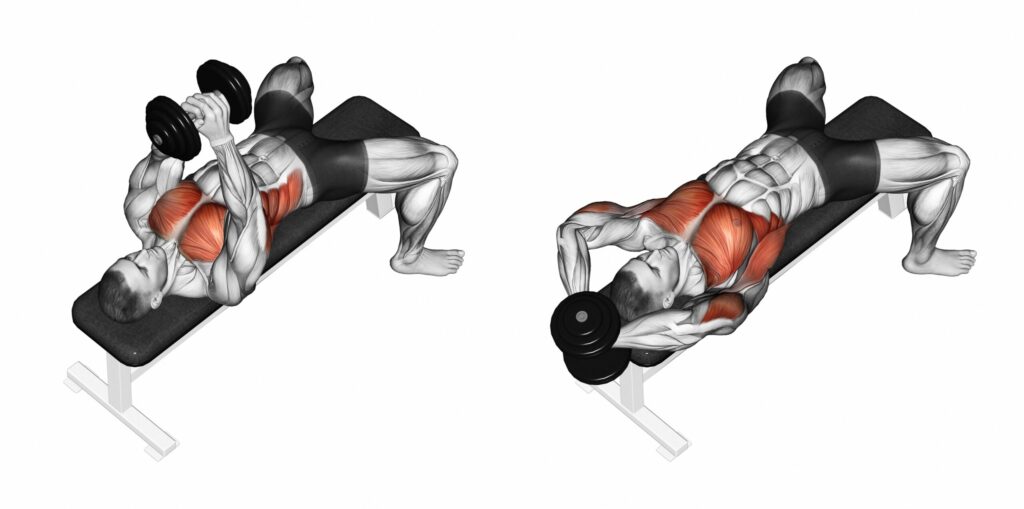
- By arranging your body in this way, the dumbbell pullover helps you focus more on your lats than your chest.
- So instead of lying flat on your back like the barbell pullover above, we advise placing yourself off the edge of the bench.
Best Latissimus Dorsi Exercises At Home (Bodyweight Lat Exercises)
For the purpose of strengthening and developing your latissimus dorsi muscle, the exercises listed below are the ideal choice, regardless of whether you want to train with body weight at home or have access to equipment.
Inverted Rows
Steps To Follow:
- Inverted rows have also earlier been discussed, although in that case, a Smith machine was employed.
- Inverted rows can be performed without a Smith machine, though it is undoubtedly the ideal option because it makes it simple to adjust the bar’s height.
- Inverted rows can be done in a variety of settings, such as under a table or in the chair arrangement shown in the above photo.
- Choose a suitable setup and complete it.
- You’re about to perform the best bodyweight row you’ve ever done.
Towel Rows
Steps To Follow:
- Grab a towel, tie it to an object roughly chest height, and start rowing.
- It’s similar to an inverted row except that you’re standing instead of sitting down.
- It’s easier, but your lats can benefit if you utilize high repetitions and volume, squeeze them really hard, and focus on their whole range of motion.
- You may also use one-arm towel rows to make it more tough.
- Alternatively, use simply your hands instead of a towel to lessen the difficulties.
- It is more difficult because the towel increases stability, range of motion, and grip demand.
Resistances Band Lat Exercies
Resistance bands can be used for all of the previously listed free-weight exercises.
As an example…
- Bent Over Rows
- Single Arm Rows
- Pulldowns
Resistance band lat workouts are the subject of another post, so we won’t go into detail here.
Programing this For Lat Muscles
There are a few things to take into account if you want to develop your lats as quickly as humanly possible:
- Type of Exercise & Variety
- Volume
- Intensity
- Progression
- Diet
Let’s discuss each of these ideas.
Types Of Exercises & Variety
For the lats, there are three primary categories of exercises:
- Vertical Pulls (i.e. pull-ups, pulldowns)
- Horizontal Pulls (i.e. rows)
- Shoulder Extension Exercises (i.e. pushdowns)
- All three of these motions are necessary for developing well-developed lats since they all engage the lat muscle in different ways.
- Furthermore, you should pay attention to how your arm moves, or more specifically, how your shoulder joint moves, as this will dictate which part of your lat is being worked the most.
- The finest exercises for the lats are shoulder adduction (wide grip pull-ups), horizontal abduction (rows), and shoulder extension (pushdowns), which works the middle and lower lats.
- Your back muscles are worked differently depending on how you hold and how your body is angled.
- This is because your shoulder joint can move in different ways.
- In addition to deciding whether or not the lat is the main emphasis, grip placement is crucial in identifying which muscle group is most advantageous.
- For instance, overhand barbell rows, which require more horizontal abduction with your arms stretched out, will target your middle lats more than reverse grip, which keeps your elbows tucked in and concentrates more on shoulder extension.
- Therefore, by simply switching up your grip, you may more easily target your middle or lower lat with the same bent-over row.
- Likewise, with regard to vertical pulls. Pulldowns and pull-ups performed with a wide grip will include greater shoulder adduction, while those performed with a snug grasp will involve shoulder extension and tucked elbows.
- Variety is crucial because of this.
- You may develop your lats to their greatest potential by switching up your grip, executing pulls that are both vertical and horizontal, and engaging in movements that are dependent on shoulder extension.
- It should be mentioned that your entire latissimus dorsi will be worked throughout any lat workout.
- Your middle, lower, or higher lats cannot be isolated.
- Once more, only specific places will essentially be activated.
- Additionally, some exercises are more effective at engaging the entire lat.
Equipment
- Equipment also contributes to variety.
- You may want to switch things up to stress your muscles in different ways (e.g., work each side separately and correct muscle imbalances with dumbbells instead of a barbell, or perform seated rows instead of bent-over rows to slightly reduce the strain on your legs and lower back).
- On the other hand, you could not have access to specific tools.
- Having stated that certain equipment is more effective than others at building lats.
- The consensus seems to be that the barbell is optimal for rows, and dumbbells are a close second.
- Pull-ups, or weighted pull-ups if you’re strong enough, are the best for vertical motions.
- They have the greatest load potential and are the hardest, which is why.
- Still, as we shall explain when we show all the many versions, other equipment, such as cable machines, most definitely has its place.
Volume
- We use both total volume and rep ranges when we talk about volume.
- For maximum lat hypertrophy, ten to fifteen repetitions is the ideal range.
- With certain exercises, you can even reach greater heights.
- Lower repetition counts are also beneficial if you want to concentrate more on strength, which you should.
- The optimal rep range for strength will fall, give or take, between 6 and 10 reps.
- It’s critical that you train for both hypertrophy and strength.
- So, change things up. In addition, you will improve strength and endurance in the hypertrophy rep ranges in addition to building pure size in any rep range.
- Your lats are a tough muscle when it comes to overall volume (weekly sets + reps).
- Consider how frequently you hear someone complain of having a torn lat.
- Most likely, you haven’t heard of that.
- The idea is, compared to many other muscles, your lats can withstand higher volumes.
- Therefore, you can increase the number of training sessions to 15-20+ for the lats if the recommended volume for each muscle group is 10-15 sets per week.
Intensity
- Without mentioning intensity and by intensity, we mean weight load volume has no meaning.
- Before we do so, it’s crucial to realize that the latissimus dorsi responds best to moderate loads for moderate to higher reps since it has an even distribution of fast and slow twitch muscle fibers.
- It will, however, perform admirably for moderately heavy weights and moderate repetitions.
- Thus, once more, you ought to be training using the comprehensive rep plan (6-10 and 10+) that we previously discussed.
- We are unable to predict the ideal weight load for you, but one simple method to determine whether it is suitable is to measure the difficulty within that rep range.
- Basically, you want the weight load to push you to the limit of your ability within the rep range if you are training for 10–12 repetitions.
- You should increase the weight load if you are exercising for hypertrophy and you can perform well beyond 15 repetitions.
- The strength rep range is no different.
- It really is that easy.
Progression
- Clearly, you are unable to maintain the same level of intensity every week.
- You must gradually increase the difficulty of your workouts if you want to gain strength and muscle.
- By doing this, you can make sure that your muscles are consistently overworked, forcing them to adapt and become stronger.
- For novices, increasing weight is the simplest way to develop; however, as you gain more experience, you’ll need to experiment with progressive overload techniques.
Diet
- We won’t get into too much detail on this one, but it goes without saying that eating a sufficient amount of food is necessary for both muscle growth and adequate strength during exercise.
- You have to eat a lot if you want to bulk up your lats. To get started, take a look at our 7-Day Muscle Gain Meal Plan!
Mind-Muscle Connection
- If you don’t have a strong mental-muscle connection with your lats, none of the previous information regarding strengthening your latissimus dorsi will matter.
- To get the highest level of lat activation throughout the workouts, you must have a strong mind-muscle link.
- Since the lats are not located on the front of the body like the chest, it is much tougher to work them out.
- Work on this, and the best way to do so is to start off really focusing on contraction with lightweight and work your way up from there.
How To add Lat Exercises Into Your Workouts
- It truly depends on what kind of training you are doing.
- When comparing a body component split to an upper-lower split or full body split, the results will differ.
- The ultimate objective is to complete more than 15 sets each week.
- This covers pushdowns/pullovers as well as pulls that are horizontal and vertical.
- Since many people perform pull- or back-days, here is an example of a well-rounded back exercise program with lots of lat volume.
| Exercise | Sets | Reps |
| Weighted Pull Ups | 3 | 6-12 |
| Bent Over Barbell Rows | 3 | 6-12 |
| T-Bar Rows | 3 | 8-15 |
| Lat Pulldowns | 3 | 10-12 |
| Lat Pushdowns | 3 | 10-15 |
| Rear Delt Flys | 3 | 15-20 |
- It’s going to be a great workout for your complete back in addition to your lats.
- You can incorporate some back extensions at the end if you feel like you need a little extra erector work.
- Just distribute the volume properly throughout the week if you perform an upper-body or full-body workout.
Progressive Overload With Bodyweight Lat Exercises
- You can increase weight load to achieve progressive overload with free weights and other equipment.
- The only method to do this with body weight is to use some kind of external load, such as resistance bands or a weighted backpack.
- To up the intensity, though, you can also use different progression techniques.
- You can perform more difficult bodyweight exercises, boost the number of repetitions and volume, cut down on rest periods, and change the cadence of your movements.
- By experimenting with these factors, you can increase the difficulty of your exercises and force your muscles to adapt more by overloading them.
- Even while it won’t be as simple as using weights, you can still develop your lats.
Benefits Of Having Strong Well Developed Lats
- The lats are an interesting muscle because, although they are not very important in the everyday lives of the normal (contemporary) person, they are quite important in athletics and fitness.
- It’s not like your quads or glutes, which get a lot of use during the day from frequent standing and walking.
- Because of this, you run the risk of having undeveloped lats if you don’t exercise.
- Even while you use your lats for activities like putting on shirts, opening car trunks, and swinging your arms while walking during the day, this is certainly insufficient.
- Thus, even if your lats might not be very important in your day-to-day activities unless you have to swim or climb, having strong lats will significantly improve your performance if you want to start getting into shape or playing a sport.
- All other things will follow if your lats are powerful, that much is true.
- That is the extent of their contribution to fitness.
- Simplified, the primary function of your lats is to assist protect, and stabilize your spine, as well as to give you shoulder and back strength.
- Thus, the more lats you have, the more resilient you will be to injuries at the spinal and shoulder levels as well as stronger at shoulder and back workouts (pulling and pressing).
- Furthermore, strengthening your lats through strength training also helps to increase their flexibility and mobility, which will improve your range of motion and overall movement quality.
- This is because strength training is a type of dynamic stretching.
- Strong lats enable you to lift higher weights and with greater intensity when deadlifting, squatting, bench pressing, overhead pressing, rowing, and pulling.
- This is crucial not only for the growth of your lats but also for the development of all the other muscles we discussed, namely your deltoids, biceps, forearms, triceps, and pecs, which are basically the muscles in your back.
- A strong, durable upper body is linked to having well-developed lats.
- The lats are an essential muscle to have well-developed in terms of appearance.
- A well-developed set of lats, shoulders, and pecs will give you a V-shaped silhouette that elongates your shoulders and narrows your waist.
- Therefore, you need to build those “wings” (an evocative phrase for lats) if you want to have an aesthetically outstanding body.
- It is not only aesthetically pleasing (to the extent that it is practically ingrained in our DNA), but it also clearly denotes authority and is readily recognizable.
Why Are My Lats So Weak?
Some of you may be thinking, ” Damn, my lats are more like flats,” after hearing all of these amazing things about lats. Why do they have such little strength?
There are several reasons why the latissimus dorsi may be weak and undeveloped.
- You don’t work out.
- You don’t work out correctly (poor form).
- Other muscles are overactive during lat exercises.
The first is simple to remedy; just begin exercising and be sure to perform a range of pulling exercises from both directions (shoulder extension exercises in addition to horizontal and vertical pulls).
See our list of late workouts if you need more motivation.
We are here because the other two require a little more understanding.
- If your form is bad (for example, you pull workouts too much using your biceps and/or traps), you should pay attention to the form of each exercise and work with a smaller weight until you understand how to engage your lats during the exercise.
- If you find that other muscles are hyperactive when you pull, and this isn’t because of bad technique, you may need to try some new exercises that more effectively work the lats in addition to strengthening the mind-muscle link, which also starts with lighter-weight.
- Changing up your grip could help you engage your lats more and somewhat deactivate other muscles.
- You can focus a bit more on your lats by, for instance, modifying the dynamics of the muscles exercised by going from overhand to underhand rows.
The good news is that by performing the workouts we discussed above, your lats can and will strengthen and expand.
Conclusion
For maximum lat growth, a well-rounded program that incorporates a variety of compound and isolation exercises is recommended. Adjust your exercise regimen to your tastes, level of fitness, and the availability of the equipment. To maximize effectiveness and reduce the chance of damage, pay attention to the appropriate form.
As your strength increases, progressively increase the weights and intensity since progressive overload is the key to ongoing growth. Never begin a new workout program without first speaking with a fitness expert or healthcare provider, particularly if you have any current health issues or injuries.
FAQs
Which workout targets the latissimus dorsi?
Although many individuals have a bad recollection of performing pull-ups in school, they are among the best exercises for building lats. This classic exercise has several variations to meet different needs. Pull-ups work your upper body as a whole. But they mostly use the climbing motion, which works your lats directly.
Which daily tasks include the latissimus dorsi?
It may surprise you to learn that performing routine tasks like picking up objects from the floor, reaching into cabinets, opening doors, and even embracing someone puts a lot of strain on our latissimus dorsi muscles.
Can you work out your lats every day?
It is normally advised to train your lats two to three times a week, with a minimum of one day off in between. You can test your muscles and encourage growth during these sessions by doing movements like lat pulldowns, pull-ups, rows, and deadlifts with different sets and reps.
Which three primary purposes does the latissimus dorsi serve?
The latissimus dorsi works with the teres major and pectoralis major to perform motions of the upper limb. At the glenohumeral joint, these muscles will cooperate to adduct, rotate medially, and extend the arm.
What is the latissimus dorsi’s primary purpose?
Functionally, the latissimus dorsi muscle is a part of the scapular motion muscles. This muscle can produce motions on the shoulder joint (internal rotation, adduction, and extension of the arm) by pulling the inferior angle of the scapula in different directions.
In real life, what is the latissimus dorsi?
These are two triangle-shaped muscles that run the length of the back, over the pelvis, and immediately below the shoulder blade on either side.
References
- Cpt, P. W. (2022, November 21). 16 Best Latissimus Dorsi Exercises. Verywell Fit. https://www.verywellfit.com/great-mid-back-lats-exercises-1231482
- Set, S. F. (2023, August 28). 14 Best Latissimus Dorsi Exercises To Build Some Serious Wings. SET FOR SET. https://www.setforset.com/blogs/news/best-latissimus-dorsi-exercises
- Latissimus Dorsi Muscle. (n.d.). Physiopedia. https://www.physio-pedia.com/Latissimus_Dorsi_Muscle


